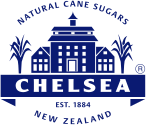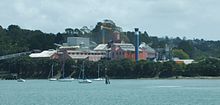Chelsea Sugar Refinery
| Chelsea Sugar Refinery
|
|
|---|---|
| legal form | Limited |
| founding | 1884 |
| Seat | Auckland |
| Number of employees | 250 |
| Branch | Food industry, sugar manufacturer |
| Website | www.chelsea.co.nz |
The Chelsea Sugar Refinery in Auckland , colloquially known as "Chelsea" or "sugar works", is a sugar refinery in Birkenhead , a suburb of North Shore City in New Zealand . It is located on the north coast of Waitemata Harbor . Founded in 1884, the company is New Zealand's main source of sugar and sugar products to this day. The old factory buildings are under monument protection. The refinery owns one of the deep water ports in the Auckland metropolitan area.
history
By the end of the 19th century, all sugar products were imported into New Zealand. In order to improve New Zealand's self-sufficiency, the New Zealand government launched an award in 1882 for the first company to produce sugar in New Zealand. Already interested in expanding into Australia, Colonial Sugar Refining Company investigated several potential locations in New Zealand and eventually bought 60 acres (0.65 km²) of farmland in Birkenhead. The area was later expanded to 1.8 km².
The location was ideal for a sugar refinery: Waitemata Harbor provided offshore deep water for a harbor, there was abundant fresh water from Duck Creek that ran through the property, and there was plenty of building land and timber.
The name Chelsea was given to the place by the refinery's first customs officer after his hometown of Chelsea in England .
New Zealand Sugar Company founded
The "New Zealand Sugar Company" was founded in June 1883 by the Colonial Sugar Refining Company , the Victorian Sugar Company and a number of prominent Auckland businessmen, including Sir Frederick Whitaker , Allan Kerr Taylor , LD Nathan of Lion Nathan and AG Horton and JL Wilson founded by Wilson & Horton . The collapse of the world market for sugar in the 1880s led to the New Zealand Sugar Company being taken over again by its co-founder Colonial Sugar in 1888 .
In 1959 the present, autonomous New Zealand Sugar Company was founded . CSR Limited (the current name of Colonial Sugar ) holds 75% of the shares.
Construction of the refinery
In 1883, work began on building the refinery. 150 workers leveled the building site, filled in a lagoon and built jetties and embankments with the help of blasting. This required two thirds of the 1.5 million bricks used to build the facility, and the remaining third for the buildings. The refinery went into operation in 1884 and has been in operation day and night ever since.
Of the 150 workers, 100 remained on site as factory workers. Most moved from Auckland to Birkenhead.
Some of the machinery and equipment was imported from Greenock in Scotland . A large part of the historical technology is preserved and protected as industrial cultural heritage.
Model village
When work on the refinery began, managers and executives converted existing farmhouses on the property into homes. However, the majority of workers lived in tents and makeshift buildings near the construction site. This barrack town has been replaced by Chelsea Village , made up of 35 houses built by the company on the company's premises . This was some distance from the existing village of Birkenhead. It was laid out as a planned model village and, in addition to the houses, included gardens, a church, a reading room, a school and a shop.
However, this village only existed for a few years. The lower-lying houses were damp and had been uninhabited since the 1890s. Around 1900 the houses were known as "barracks" and were mainly inhabited by single men. In 1905 the village was declared ripe for demolition by the health authorities and the worst houses were demolished, the rest was sold and relocated to other places. Some of the relocated houses can be seen in the older streets around Birkenhead. The church, now St. Peters, was transferred to the suburb of Verrans Corner .
Wanting to have its management team on site in case of an emergency, the company built four brick-built semi-detached houses on the site of the old Chelsea Village in 1909. These houses are still owned by Chelsea but are now rented to private individuals. For the other workers, the company offered cheap home-building loans, which helped finance over a third of the new houses built in Birkenhead from 1910 to 1926. These houses are primarily in the streets around the refinery, including Colonial Road, named after the founding company, and Huka Road (after the Maori name for sugar).
Sugar workers
The poet James K. Baxter worked briefly in 1969 as a cleaner in the company: the poet Hone Tuwhare got him this job . After three weeks he was released and wrote his satirical poem "Ballad of the Stonegut Sugar Works" on it, which expressed his dissatisfaction with the working conditions. However, Baxter's impression of the factory was not shared by all workers. Despite the hard work, there was a sense of community and the company gave workers numerous perks, including home-building loans and job security. This resulted in a low fluctuation. Often entire generations of a family worked in the refinery.
Influence of the company
Development of Birkenhead
Before the opening of the Auckland Harbor Bridge in 1959, access to the North Shore from Auckland was only possible by ferry without any major detours. While some residents work as commuters in the city, development in Birkenhead has been largely determined by the local employers. The main employer, Chelsea, was a determining factor in the development of the place. Birkenhead was considered by many to be the "factory town" of Chelsea. In 1900 the population of the borough reached the 1000 mark. Two thirds of the men worked in the refinery. The farmers and fruit growers in the area also relied on casual work in the factory outside of the agricultural season.
Before the refinery was built, the region was dominated by farms and orchards. A small village existed near Birkenhead Wharf . Within four years of the refinery's operations, Birkenhead was a borough. The booming new town grew up the hill towards Chelsea Village , with a few shops opening in Highbury, between the two villages. Most of the businesses were supported by Chelsea and its workers. The workers became involved in community affairs and also became mayors and councilors. The siren at the change of shift could be heard all over Birkenhead and served as a timer for everyone.
Seaport in Waitemata Harbor
The location of the refinery was chosen partly because of the deep water access. A port was built in 1884. The raw sugar came from Fiji , Cuba , Australia , Indonesia and Peru . After processing, the finished products were also shipped across the harbor until the Auckland Harbor Bridge was built . All other goods such as coal, food and mail came by ship as well.
The port made today Handysize - bulk carriers from which up to 30,000 tons of raw sugar transport.
Ports of Auckland owned nine acres of land in Chelsea , which was leased to Chelsea. In 1997 the area was sold to Chelsea.
Influence on architecture and culture
The company archive was given to the Birkenhead Public Library. These Chelsea Archives contain company records, legal files, payrolls, and share registers from the company's history.
The original factory buildings, director's mansion and brick houses have been classified as Category II cultural heritage by the New Zealand Historic Places Trust , and the entire complex as an industrial monument.
Chelsea has given the public access to its vast expanses of wetlands, lakes, open spaces and bushland throughout its history. In order to keep the areas publicly accessible and to ensure the maintenance of the areas, extensive areas were given to a public foundation in 2005.
The company today
Chelsea still works around the clock to this day and is New Zealand's market leader in sugar products. Chelsea buys the raw sugar from various Pacific islands and Australia. In 2014, 27,000 tons of raw sugar from Queensland in Australia were delivered to Chelsea for further processing every 6 weeks .
We start with raw sugar cane shipped right to the refinery door from Queensland in Australia. And we get a lot of it - around 27,000 tons every six weeks, which is enough to cover the whole of New Zealand. From there it's refined and packed into the range of Chelsea products you see on the supermarket shelf.
Chelsea supports and sponsors a variety of local organizations and projects in the community. The company also funds the Sugar Research Advisory Service , an organization dedicated to sugar research.
literature
- Peter Luke: Sugar Workers, Sugar Town: An Oral History of Chelsea Sugar Refinery, 1884-1984. In: New Zealand Sugar Company Limited (Ed.): New Zealand Heritage . Auckland 1984, ISBN 0-473-00270-1 (English).
- Margaret McClure: The Story of Birkenhead . Ed .: Birkenhead City Council. Auckland 1987 (English).
- Kathy Haddon: Birkenhead: The Way We Were . Ed .: Birkenhead Library. North Shore City Council 1993, ISBN 0-9597936-7-4 (English).
- Shelley Howells: Pretty in Pink . Ed .: New Zealand Historic Places Trust. Issue 103, Summer, 2006 (English).
Web links
- Homepage . Chelsea Sugar Refinery,accessed August 9, 2014.
Individual evidence
- ↑ a b About Us . Chelsea Sugar Refinery , accessed August 9, 2014 .
- ^ A b Luke : Sugar Workers, Sugar Town . Auckland 1984, p. 8 (English).
- ^ A b The History of Chelsea Sugar Refinery . Chelsea Sugar Refinery , accessed August 9, 2014 .
- ^ Luke : Sugar Workers, Sugar Town . Auckland 1984, p. 9 (English).
- ↑ a b c Howells : Pretty in Pink . 2006, p. 17 (English).
- ^ Sugar . CSR Ltd , archived from the original on July 19, 2008 ; accessed on August 9, 2014 (English, original website no longer available).
- ^ A b Luke : Sugar Workers, Sugar Town . Auckland 1984, p. 5 (English).
- ↑ Howells : Pretty in Pink . 2006, p. 18 (English).
- ^ A b c Luke : Sugar Workers, Sugar Town . Auckland 1984, p. 6 (English).
- ↑ Baxter, James K. . New Zealand Book Council , accessed April 22, 2018 .
- ^ Luke : Sugar Workers, Sugar Town . Auckland 1984, p. 3 (English).
- ^ A b Luke : Sugar Workers, Sugar Town . Auckland 1984, p. 7 (English).
- ^ A b Luke : Sugar Workers, Sugar Town . Auckland 1984, p. 4 (English).
- ↑ Howells : Pretty in Pink . 2006, p. 19 (English).
- ^ September 1997 decisions - Chelsea Sugar Refinery buys nine hectares leased from Ports of Auckland . Campaign Against Foreign Control of Aotearoa (CAFCA) , accessed August 9, 2014 .
- ↑ Chelsea Archives . North Shore Libraries , archived from the original on March 16, 2009 ; accessed on August 9, 2014 (English, original website no longer available).
- ↑ Howells : Pretty in Pink . 2006, p. 17-18 (English).
- ^ Historic Chelsea Estate To Become Public Legacy . (PDF (86 kB)) Chelsea Sugar Refinery , December 20, 2005, archived from the original on October 15, 2008 ; accessed on August 9, 2014 (English, original website no longer available).
- ↑ Homepage . Sugar Research Advisory Service , accessed August 9, 2014 .
Coordinates: 36 ° 48 ′ 42.1 ″ S , 174 ° 43 ′ 26.4 ″ E





